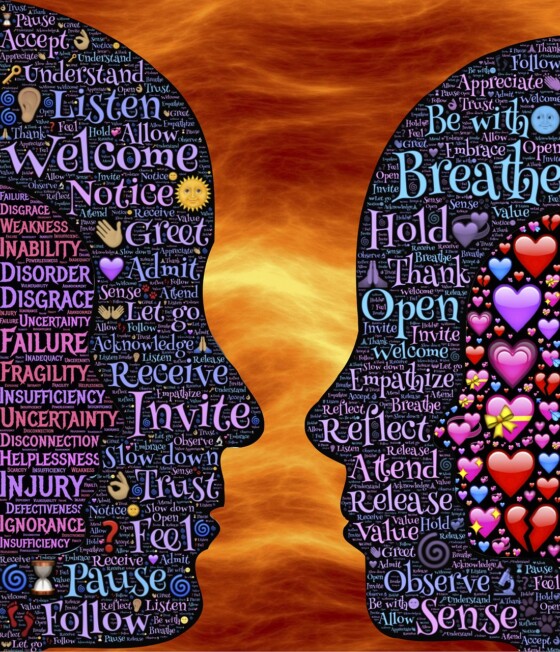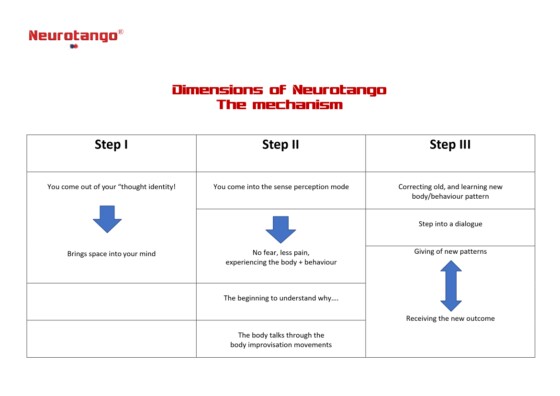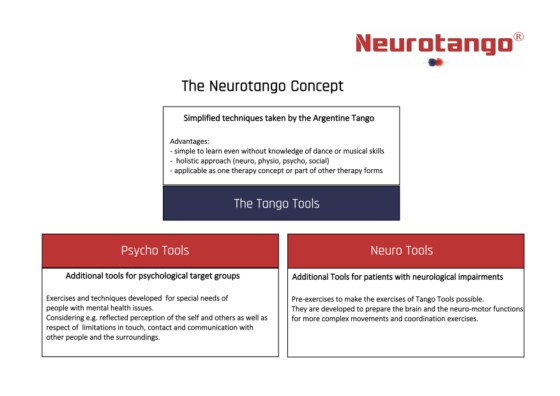PSYCHOLOGY
PSYCHOLOGICAL TARGET GROUPS
Psychological application examples Neurotango®
- Social phobia
- Burnout
- Inclusion courses
- Integration courses
- Obesity
- Eating disorders
- People with a boundary violation
- Narcissism
- Dependencies of all kinds
- Trauma consequences (e.g., aggression, depression)
- Compulsive acts
- Perfectionism
- ADHD, ADD
- Autism Spectrum
- Couple problems (topics: roles, dominance, responsibility, separation, finding a partner)
The impact and effect observed in these target groups can be found here.
Menchanism of Neurotango® in Psychotherapy
The Neurotango® Resonance Method is:
1. An analytical method that works through non-verbal communication, as well as going in resonance with and through one's own body.
The participants/patients express their current state unconsciously through their body language. Partners, colleagues, family, environment react to it in a certain way so that the outer world is created by the resonance of the inner state. The "outside" also includes the physical state (state of health, physical posture and movement). Depending on the frequency he or she emits, there is only a certain range of possibilities which can be reflected in life situations. Body language makes it possible to create a different frequency by intentional change of movement/posture/behaviour. It creates a new range of possibilities in all life situations. Here we come to the therapeutic part of the Neurotango® Resonance Method.
2. A therapeutic method through physical training of new movements and behaviour patterns. The NTT (Neuro Technical Tools) bring new dynamics (speed, size and intensity) into movement/posture/behaviour. This automatically creates inner frequencies. In couple exercises, they are supported by non-verbal, improvised dialogues. Despite choreographic exercises, each couple communicates differently. Through the exercises, the partners change their behaviour, movements, and reactions. Without these changes, it is mostly not possible to move forward in the same rhythm and in the same direction. And without empathy towards the partner and without going outside (away from one's own drama), progress is not possible. Here, too, we see that body language behaviour and psychological "behaviour" are connected. The partners are the resonating bodies of their own behaviour/movement/attitude.

NEUROTANGO® PSYCHOTOOLS (NPT)
Neurotango® Psychotools
In
psychotherapeutic practice, and especially in the clinical field, it has become
apparent that many disorders require additional tools for the application of
NTT (Neuro Technical Tools) in order to meet the special needs of the target
group of mentally ill people.
Especially
people with anxiety disorders or trauma need preparatory exercises before
therapists can work with NTT. These additional tools (NPT) are designed to
prepare for problems such as entering a new room, being in a group, and touching
or being with other people. In individual cases, it is also necessary to decide
which music is supportive and relieving or which music should be avoided
because it creates a negative emotional stimulus. Music is neuronally directly
linked to the "emotion memory", which enables quick access to
emotionally linked events, but can also create an overload or a sudden burst of
feelings. (See also above studies on the effect of music on the psyche). With
the psycho-tools of our concept, we can slowly prepare the body therapy and the
work with music.
RECOGNITION BY THE CHAMBER OF PSYCHOTHERAPISTS
In 2022, a Neurotango® concept for psychotherapists was officially recognized as advanced training by the NRW Chamber of Psychotherapists. At the moment, unfortunately, no advanced training is offered here, as there are no Neurotango Masters available from this area.
We would be happy to train you as a Neurotango® Practitoner and Master to take on this very trustworthy task.
Neurotango® in comparison with behavioural therapy and depth psychotherapy
Depth Psychotherapy
Above all,
depth psychotherapy is usually very long-term in order to be able to dissolve emotionally
linked patterns which possibly already were experienced in childhood. Here,
too, new patterns are created by discovering, remembering, and re-experiencing the
emotions linked with negative patterns.
The positive
aspect of long-term work with the therapist is the building of trust. However,
this can also lead to the patient´s adoption of patterns, memories and
expectations coming from the therapist. In other words, a loss of neutrality.
In body
therapy is in resonance with the body and, therefore, more explicit and more
authentic than talk therapy. Cognitive statements are influenced by many
factors, such as the momentary state of mind, influence and expectation from
the outside, current emotional needs, etc. The body, on the other hand, never
lies and even shows physical reactions (goosebumps, feeling hot or cold,
ability to communicate, rigidity, discomfort, sudden onset of physical pain,
tears) which appear through movements linked with emotions (music, couple
situation, movement sequence). Normally these are less strong reactions in
movement therapies. Feelings generated by movements with music (NTT or NPT
exercises) are expressed verbally for better cognitive processing. It is quick,
authentic, and direct access to the patient's memories and emotions. It gives a
realistic picture and a direct solution as well. A combination with verbal
expression (talking therapy) can be an ideal solution for psychotherapy.
Behavioural therapy:
Behavioural therapy aims to recognize harmful patterns in behaviour and replace them with changed behaviour. The patient talks about life situations and mostly the results of their behaviour.
After recognising "disturbing" behaviour patterns, the patient can change their behaviour patterns bit by bit in order to positively influence his/her own well-being and the resonance of the environment. For the most part, the emotional "reasons and linkings", why and how the earlier patterns arose, remain unconsidered. So, there is an emotional gap that can lead to the return of old behavior patterns. The change to the new behaviour can be only partially authentic. It is cognitively deemed good and reinforced by positive experiences. However, in the case of strong emotional patterns, e.g., from childhood, these can erupt again in triggering situations or interactions.
Neurotango® is a combination of discovering and processing the emotion, including the change of behavioural patterns. The body discovers faulty behaviour patterns or blockages immediately. These can also lead to being unable to perform movements or exercises because psychological barriers prevent them from doing so. Sometimes a period of inner and cognitive awareness is needed to master both. Physical exercise and psychological development. Both happen in parallel. Suddenly the participant will be able to do the exercise and the psychological change is clearly visible in a social change (e.g., new partnership, new job, change of flat etc.).

